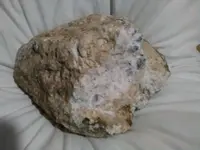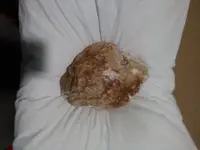You are using an out of date browser. It may not display this or other websites correctly.
You should upgrade or use an alternative browser.
You should upgrade or use an alternative browser.
METEORITE??
- Thread starter spaceyyzz
- Start date
- Joined
- May 28, 2010
- Messages
- 20,429
- Reaction score
- 32,575
- Golden Thread
- 1
- Location
- White Plains, New York
- 🥇 Banner finds
- 1
- 🏆 Honorable Mentions:
- 1
- Detector(s) used
- Nokta Makro Legend// Pulsedive// Minelab GPZ 7000// Vanquish 540// Minelab Pro Find 35// Dune Kraken Sandscoop// Grave Digger Tools Tombstone shovel & Sidekick digger// Bunk's Hermit Pick
- Primary Interest:
- Metal Detecting
No. It looks like a conglomerate rock, or Caliche (ka-lee'-chee, or sometimes klee'-chee) is a sedimentary rock, a hardened natural cement of calcium carbonate that binds other materials—such as gravel, sand, clay, and silt. It occurs worldwide, in aridisol and mollisol soil orders—generally in arid or semiarid regions, including in central and western Australia, in the Kalahari Desert, in the High Plains of the western USA, in the Sonoran Desert, and in Eastern Saudi Arabia Al-Hasa. Caliche is also known as hardpan, calcrete, kankar (in India), or duricrust. The term caliche is Spanish and is originally from the Latin calx, meaning lime.Caliche is generally light-colored, but can range from white to light pink to reddish-brown, depending on the impurities present. It generally occurs on or near the surface, but can be found in deeper subsoil deposits, as well. Layers vary from a few inches to feet thick, and multiple layers can exist in a single location.
In northern Chile and Peru, caliche also refers to mineral deposits that include nitrate salts.[SUP][1][/SUP] Caliche can also refer to various claylike deposits in Mexico and Colombia. In addition, it has been used to describe some forms of quartzite, bauxite, kaolinite, laterite, chalcedony, opal, and soda niter.
A similar material, composed of calcium sulfate rather than calcium carbonate, is called gypcrust.
In northern Chile and Peru, caliche also refers to mineral deposits that include nitrate salts.[SUP][1][/SUP] Caliche can also refer to various claylike deposits in Mexico and Colombia. In addition, it has been used to describe some forms of quartzite, bauxite, kaolinite, laterite, chalcedony, opal, and soda niter.
A similar material, composed of calcium sulfate rather than calcium carbonate, is called gypcrust.
Similar threads
- Replies
- 26
- Views
- 816
Users who are viewing this thread
Total: 1 (members: 0, guests: 1)





